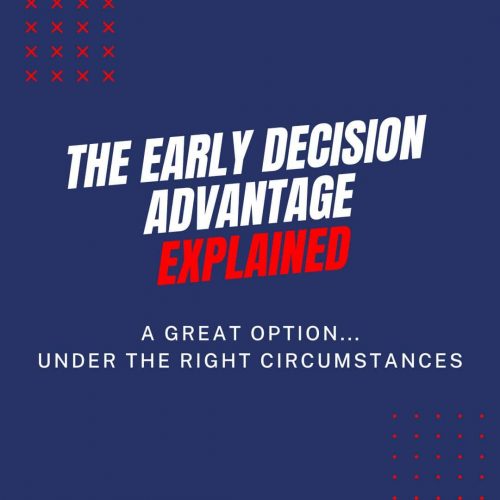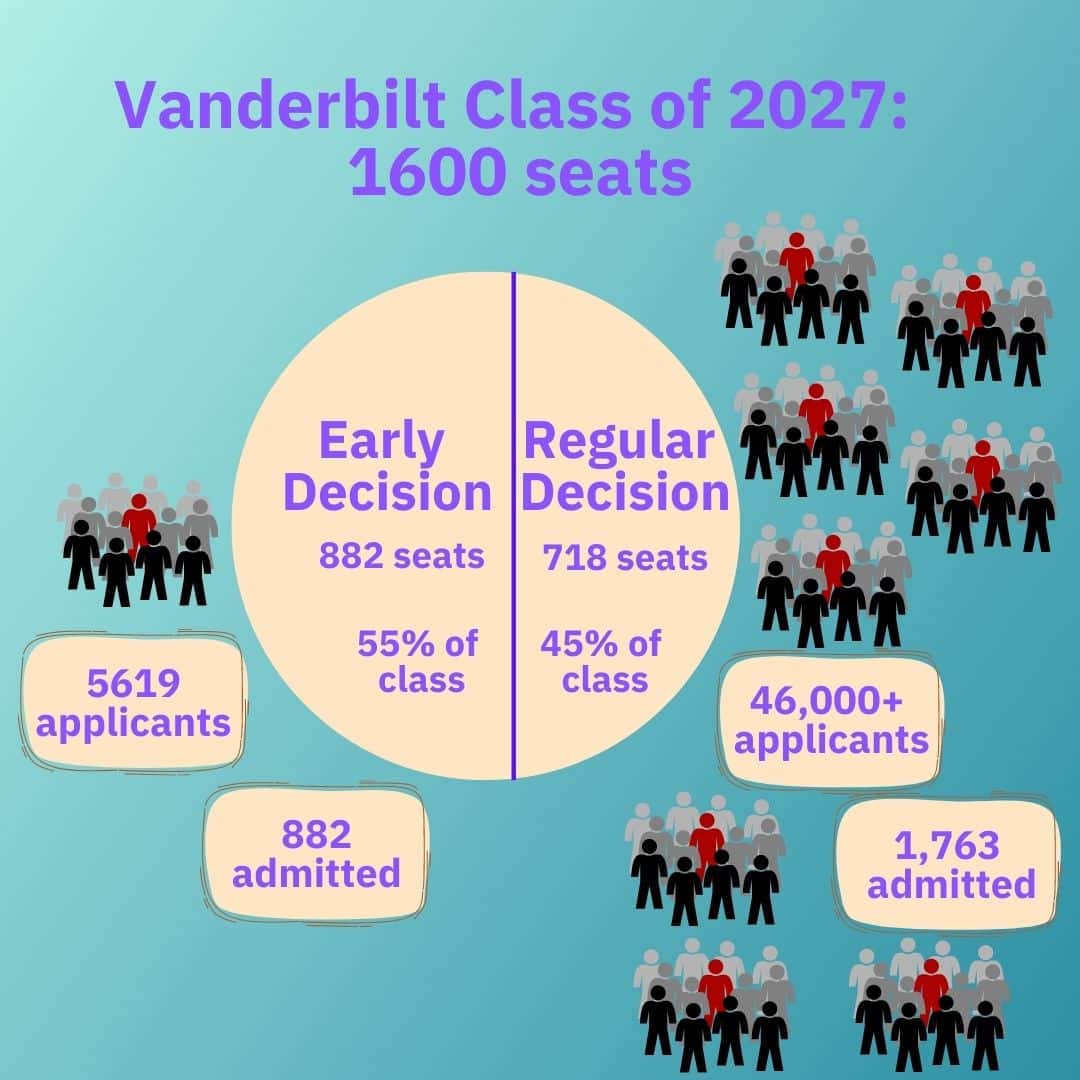
In today’s competitive college admissions climate, many students would jump at the opportunity to double, triple, or even quadruple their chances of admission to a college high on their list. Such a way exists—it’s called Early Decision (ED), and it can be a great strategy for many students. Applying ED isn’t appropriate for everyone, but understanding how this decision plan works can help families evaluate whether it’s a viable and desirable option.
ED is a binding decision plan through which the student applies relatively early in the application cycle (usually by November 1) and agrees to enroll and withdraw all other applications if admitted when ED results are released (typically by mid-December). The only “out” from this agreement is if a student receives insufficient need-based financial aid. ED is distinguishable from Early Action (EA), which also accelerates the admissions timeline but is non-binding. Given the binding nature of ED, students may apply ED to only one university at a time, though they may be permitted to apply to other colleges under non-binding plans while their ED application is pending. Some universities offer a second round of Early Decision (ED2), which carries a later application deadline (typically around January 1). ED2, ostensibly designed for applicants who need more time before making a binding commitment, often functions as a “second first choice” for students who are not admitted to their first-choice ED1 institution. A small number of universities, including Harvard University, Stanford University, and Georgetown University, offer early plans that are not binding but nevertheless restrictive in some way. The specific parameters vary among these plans, often called Restrictive Early Action (REA) or Single-Choice Early Action (SCEA), but they typically preclude applicants from applying to other colleges via REA, SCEA, or ED. Essentially, each student gets a single “golden ticket” (or two in the case of ED2).
Most universities that offer ED are private, but some public institutions, including Miami University, the University of Virginia, and the University of Vermont, also offer the option. Accepting students under ED plans provides colleges with the certainty that admitted students will enroll, critical information for purposes of enrollment management, a process through which a college employs a complex set of predictive models to enroll its desired number of students. Enrollment management ensures that a college has adequate resources for educating, housing, and feeding its students (essentially, the right numbers of heads and beds). When students are admitted via ED, the university knows they will enroll (yield), furthering the school’s ability to plan around its enrollment goals. Additionally, yield is a metric frequently used in rankings methodologies and that theoretically reflects a college’s desirability. Because of these benefits, many institutions admit a significant percentage, sometimes in excess of 50%, of their first-year classes through ED.
Early Decision also provides a considerable advantage to students. ED offer rates at many universities are substantially higher than those in the EA or Regular Decision (RD) rounds. The disparity between ED and RD offer rates may not be as dramatic as the statistics suggest because a good number of ED spots at many colleges are allotted to recruited athletes. Fundamentally, ED does not make it “easier” to get into selective colleges as colleges do not relax their standards for ED applicants. “It’s the same student that we’re looking for [across all cycles],” explained Vanderbilt University Dean of Undergraduate Admissions Doug Christiansen. Nevertheless, applying ED does make it significantly easier to stand out because the restrictive nature of ED (along with REA and SCEA) renders the early applicant pools much smaller—each student can only swim in one at a time. The value of being considered in a smaller applicant pool cannot be understated, especially in light of the explosive growth in college applications since the pandemic.
Many universities selectively release statistics around their admissions processes, but some institutions are refreshingly transparent about the numbers of students admitted under the various decision plans. The charts below illustrate the ED advantages enjoyed by members of the incoming Class of 2027 at several popular universities.
| ED offer rate | RD offer rate | Overall offer rate | % of class admitted ED | |
|---|---|---|---|---|
| Vanderbilt University | 15.7% | 4.2% | 5.6% | ~55% |
| Dartmouth College | 19% | 4% | 8.3% | ~55% |
| Williams College | 27% | 9.8% | 9.8% | ~44% |
| Duke University | 16.5% | 4.8% | 6% | ~45% |
| Emory University | 31% (ED1) 11.7% (ED2) | 7.6% | 10.3% | ~67% |
Data for the University of Virginia is reported separately because UVA also releases EA offer rates and is a public institution with different offer rates for Virginians and non-Virginians.
| Virginia residents | Out-of-state students | |
|---|---|---|
| ED offer rate | 31%* | 17%* |
| EA offer rate (non-binding) | 27% | 12% |
| RD offer rate | 13% | 8% |
*collectively, in-state and out-of-state students admitted ED make up approximately 25% of UVA’s Class of 2027
Many other universities are less forthcoming with admissions statistics and breakdowns of offer rates among the various decision rounds, but this information can often be gleaned from higher education industry data reporting tools. While RD offer rates remain undisclosed, the chart below illustrates the ED and overall offer rates for the Class of 2026 at several popular institutions:
| ED offer rate | Overall offer rate | % of class admitted ED | |
|---|---|---|---|
| Tulane University | 67% | 8.4% | 68.2% |
| University of Miami | 56.7% | 19% | 41% |
| Lehigh University | 66% | 36% | 56.9% |
| Bucknell University | 54.1% | 32.5% | 50% |
| Boston University | 25.3% | 14.3% | 44% |

The trade-off, of course, is that being admitted ED means that the student actually has to attend that university. In the Vanderbilt example, students should ask themselves how they would feel if Vanderbilt called on Halloween and offered them admission so long as they accepted on the spot. If they’d be thrilled, ED is probably the right move to optimize their chances of being admitted to one of their top-choice schools. Students who receive admissions offers via ED rarely suffer from FOMO (fear of missing out). They love being “done” with the process early and are excited they’ll be attending one of their top choice schools. Early, binding acceptances enable students to avoid the admissions stress surrounding them and move on to more exciting aspects of the college experience such as securing housing and finding a roommate.
If, however, students are not sure that Vanderbilt is their top choice (or a strong frontrunner) and would always wonder about the path not taken, ED is not the best option. Many students target specific universities (or types of universities) that do not offer ED, particularly large public flagship universities. However, many highly-popular state flagships, such as the University of Michigan, the University of Texas, and the University of North Carolina, have low offer rates, particularly for out-of-state students. If a student is torn between, say, Vanderbilt and Michigan, applying ED to Vanderbilt may be an ideal strategy. If, however, the student wants Michigan above all else, it would be unwise to ED to Vanderbilt. The student must understand that foregoing ED significantly reduces the probability of receiving an admission offer from Vanderbilt. That student must also consider the possibility of not receiving an offer from either Michigan or Vanderbilt and evaluate the desirability of attending other schools that are more likely to extend an offer. Foregoing ED is a perfectly valid decision, so long as families have considered all likely scenarios and understand that applying RD dramatically lowers students’ chances of receiving an offer from many schools that offer ED.
Some students express concern about applying ED because they want to have a “choice” about which college they attend. ED does not remove the element of choice—it merely accelerates it. Every student can only choose one college in the end anyway, and leveraging an ED strategy can actually increase the options available to a student. Nevertheless, students and parents must be comfortable with the binding nature of ED. Visiting potential ED schools generally helps in this regard, as spending time on a campus enables students to assess whether they realistically see themselves fitting into that community.
Early Decision is also inadvisable for students who wish to compare merit or need-based financial aid packages. Some schools pledge to meet 100% of a student’s demonstrated financial need (as determined by the college’s formulas), but some colleges cannot make this guarantee. Additionally, families’ perceptions as to what they can afford may differ from the college’s determination of the Expected Family Contribution (EFC). Breaking an ED agreement because a family does not want to pay or prefers to shop aid offers is not allowed. Families are expected to evaluate the cost of attendance and can use tools such as Net Price Calculators on college websites to determine if the school is financially feasible before a student applies ED
Early Decision can amplify the already heightened emotions around applying to college, especially because students are advised to avoid setting their hearts on a single “dream school.” It’s helpful for students and parents to think of ED as a strategic option, rather than the culmination of their hopes for an ideal college experience. ED is a win-win of sorts: if students are admitted, they “have” to attend a school that is among their top choices. If, however, students are not admitted, they know they took their best shot and are free to consider other schools. ED is not right for every student, but with thorough research and reflection, this decision plan can be a powerful tool in a student’s application arsenal
